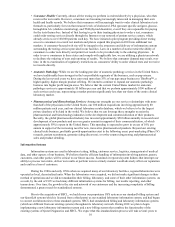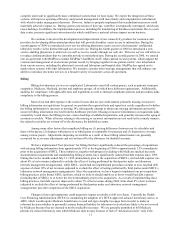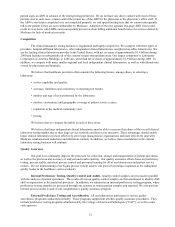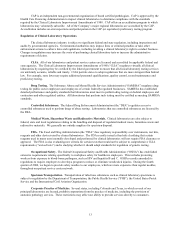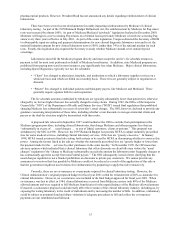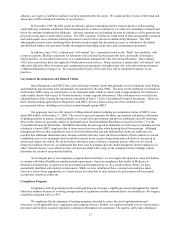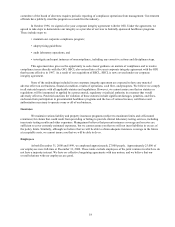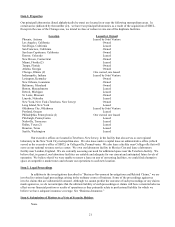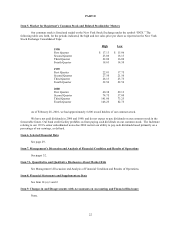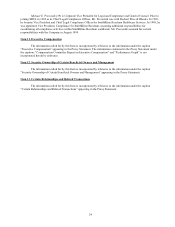Quest Diagnostics 2000 Annual Report Download - page 40
Download and view the complete annual report
Please find page 40 of the 2000 Quest Diagnostics annual report below. You can navigate through the pages in the report by either clicking on the pages listed below, or by using the keyword search tool below to find specific information within the annual report.20
(3) the absence of indemnification from SmithKline Beecham for:
(a) governmental claims against SBCL that arise after August 16, 1999; and
(b) private claims unrelated to the indemnified governmental claims or investigations; and
(4) the absence of indemnification for consequential damages from either SmithKline Beecham or
Corning.
(f) Failure to obtain new customers at profitable pricing or failure to retain existing customers, and reduction in
tests ordered or specimens submitted by existing customers.
(g) Failure to efficiently integrate acquired clinical laboratory businesses, particularly SBCL’s, or to efficiently
integrate clinical laboratory businesses from joint ventures and alliances with hospitals, and the costs related
to any such integration, or to retain key technical and management personnel. See “Business – Integration
of SBCL Operations.”
(h) Inability to obtain professional liability insurance coverage or a material increase in premiums for such
coverage. See “Business – Insurance.”
(i) Denial of CLIA certification or other license for any of Quest Diagnostics’ clinical laboratories under the
CLIA standards, by HCFA for Medicare and Medicaid programs or other federal, state and local agencies.
See “Business – Regulation of Clinical Laboratory Operations.”
(j) Adverse publicity and news coverage about us or the clinical laboratory industry.
(k) Computer or other system failures that affect our ability to perform tests, report test results or properly bill
customers, including potential failures resulting from systems conversions, including from the integration of
the systems of Quest Diagnostics and SBCL, telecommunications failures, malicious human act (such as
electronic break-ins or computer viruses) or natural disasters. See “Business – Information Systems” and
“Business – Billing.”
(l) Development of technologies that substantially alter the practice of laboratory medicine, including
technology changes that lead to the development of more cost-effective tests such as (1) point-of-care tests
that can be performed by physicians in their offices and (2) home testing that can be carried out without
requiring the services of clinical laboratories.
(m) Issuance of patents or other property rights to our competitors or others that could prevent, limit or interfere
with our ability to develop, perform or sell our tests or operate our business. See “Business – The United
States Clinical Laboratory Testing Market.”
(n) Development of tests by our competitors or others which we may not be able to license or use of our
technology or similar technologies or our trade secrets by competitors, any of which could negatively affect
our competitive position.
(o) Development of an Internet based electronic commerce business model that does not require an extensive
logistics and laboratory network.
(p) The impact of the privacy and security regulations issued under HIPAA on our operations (including its
medical information services) as well as the cost to comply with the regulations. See “Business –
Confidentiality of Health Information.”
(q) Changes in interest rates causing a substantial increase in our effective borrowing rate.
(r) An ability to hire and retain qualified personnel or the loss of the services of one or more of our key senior
management personnel.


